New York City rents are at an all-time high, and much of that can be attributed to low housing inventory – reports show that the vacancy rate has been below 2% for the past seven months, and that people are holding onto the apartments they have, thus not freeing up any inventory. Indeed, CityRealty listings show only 4,190 publicly listed apartments for rent, or less than half the 8,407 available units on the market at this time last year.
This comes at a time when affordable housing program 421a is expected to expire on June 15, 2022. In a nutshell, the program provides property tax breaks to developers in exchange for including a percentage of rent-stabilized units in their new buildings. Some progressives see it as a handout to developers who they think hardly need the help; the developers, on the other hand, see it as essential to multifamily construction given the city’s astronomical property taxes.
In this article:
At a state level, Governor Kathy Hochul has acknowledged that 421a will likely lapse. Some industry executives have emerged in favor of the replacement program that she proposed, but lawmakers rejected it on grounds that it was too similar to the current program. At a city level, Mayor Eric Adams is being pressed for his affordable housing plan. During his campaign, he emerged as a strong proponent of reforming zoning rules to allow for more new development in wealthy neighborhoods and doubling the city’s capital investment in housing, including public housing and the preservation and development of affordable homes. His plan has not yet been announced, but the city says it is being formulated with input from people who have firsthand experience with homelessness and public housing.
The Real Deal predicts that when 421a expires, few if any multifamily construction projects will begin in New York. However, The New York Times notes that in recent months, developers have rushed to break ground before 421a expires so as to qualify for tax breaks before the deadline. Below, we take a look at recently revealed renderings throughout New York City. Crucially, a number of these will include a percentage of affordable housing units.
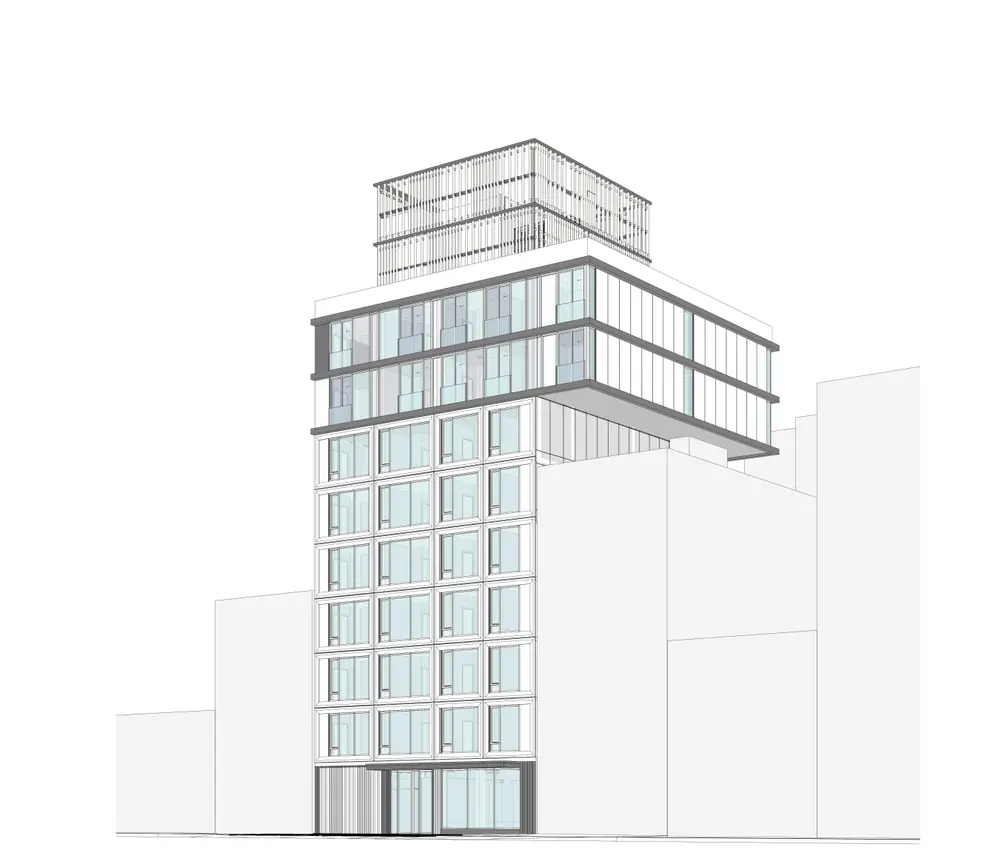 Rendering of 183 Chrystie Street (JM Zoning)
Rendering of 183 Chrystie Street (JM Zoning)
The Lower East Side’s building boom shows no sign of slowing down—permits have been filed for a nine-story building at 183 Chrystie Street between Stanton and Rivington Street. The mixed-use building calls for 26 residences (most likely condos) and 1,699 square feet of commercial space.
GF55 Partners is listed as the architect of record, and the developer was listed as 185 Chrystie Street LLC. An estimated completion date is not yet available, but demolition permits for the two-story building currently on site have been filed.
The project is underway at a time when park-facing real estate is in high demand, and when condos facing Sara D. Roosevelt Park have been doing well: Closings recently commenced at 199 Chrystie Street at an average price of $2,201 per square foot; remaining availabilities start at $3 million. In the opposite direction, current availabilities at the ODA-designed 175 Chrystie Street start at $2.546 million.
GF55 Partners is listed as the architect of record, and the developer was listed as 185 Chrystie Street LLC. An estimated completion date is not yet available, but demolition permits for the two-story building currently on site have been filed.
The project is underway at a time when park-facing real estate is in high demand, and when condos facing Sara D. Roosevelt Park have been doing well: Closings recently commenced at 199 Chrystie Street at an average price of $2,201 per square foot; remaining availabilities start at $3 million. In the opposite direction, current availabilities at the ODA-designed 175 Chrystie Street start at $2.546 million.
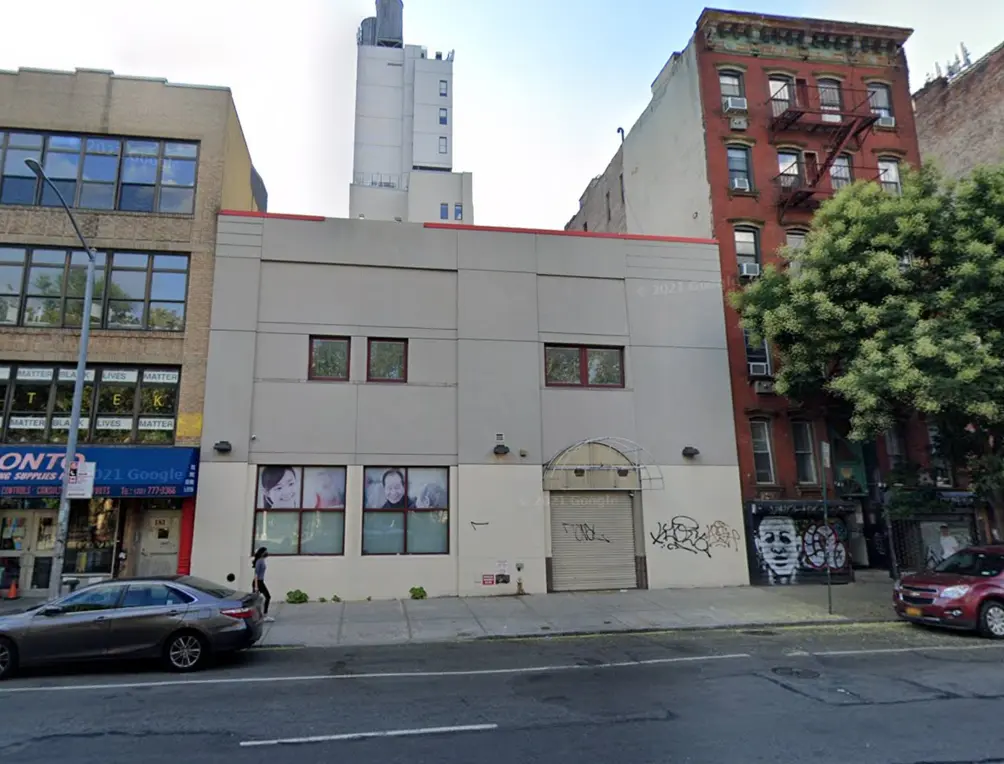
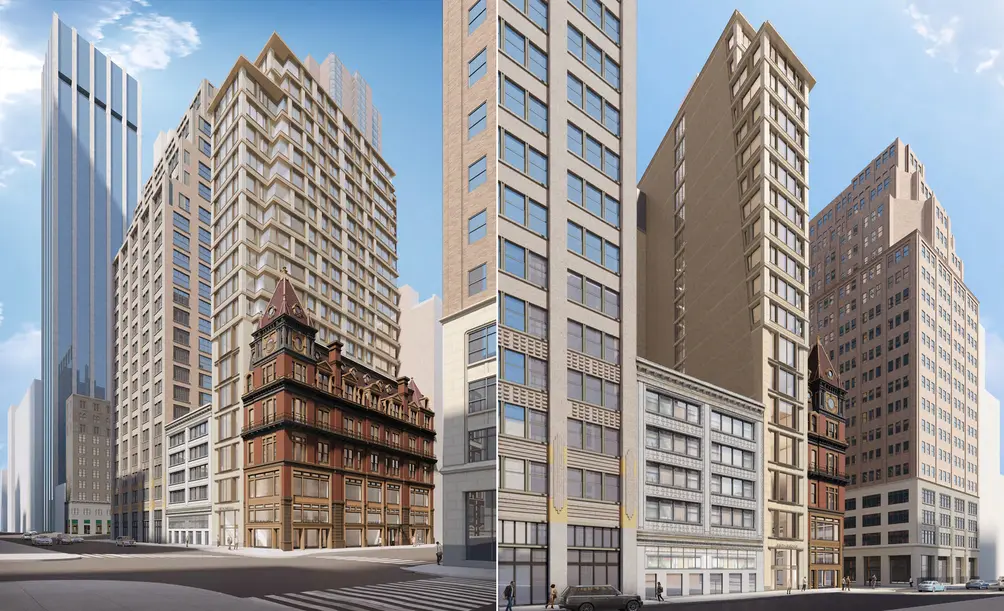
The stretch of Broadway and Fifth Avenue between 24th and 32nd Streets is now known as NoMad, but a good portion of this area is located within the boundaries of the Madison Square North Historic District. For this reason, the team behind a new building at 251-253 Fifth Avenue (located between East 28th and 29th Streets) was required to seek Landmarks’ approval for their project.
As it currently stands, the site features a Queen Anne-style French flats building designed by George B. Post at 251 Fifth Avenue and described by The New York Times as the home to some of the earliest apartment buildings in the city. Directly next door at 253 Fifth Avenue is a store and office building designed by Charles C. Thain. The proposal calls for the restoration of 251 Fifth Avenue and the replacement of 253 Fifth Avenue with a new mixed-use building.

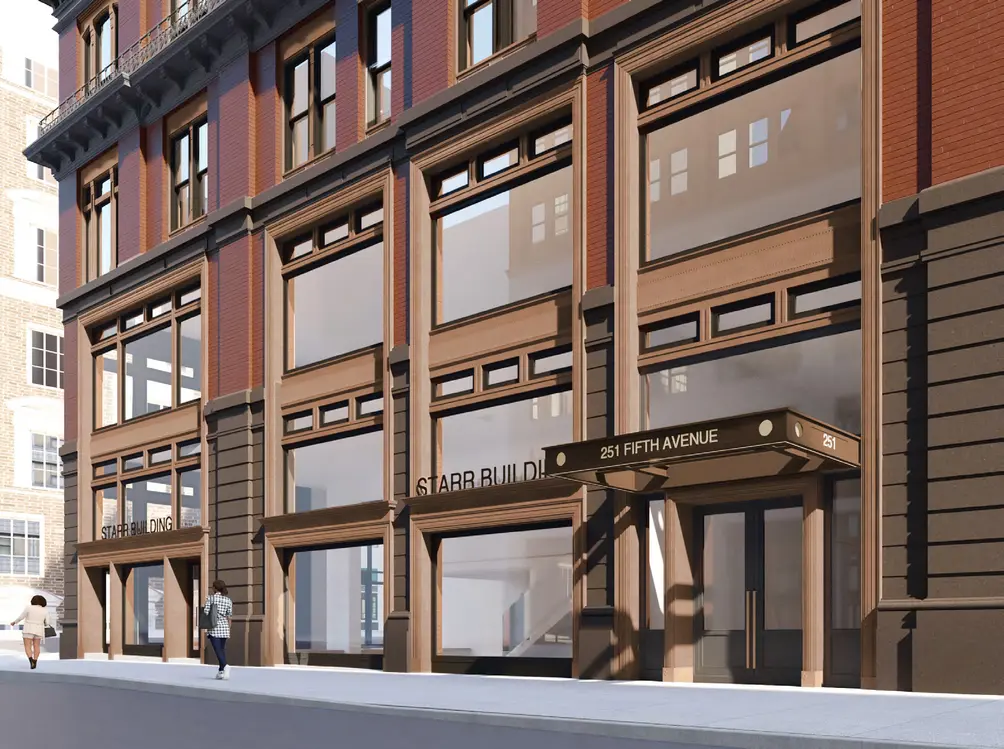 New awning proposed for 251 Fifth Avenue
New awning proposed for 251 Fifth Avenue
A presentation prepared by TRA Studio depicts a new building with oversized windows, terra cotta panels, and a cantilever over the restored building. It also shows historically sensitive materials for the restoration of the old building, as well as numerous examples of the architectural elements seen throughout the historic district. The project calls for 86 new housing units, 30% of which would be rent-stabilized, and a full floor of amenities.
Landmarks generally supported the demolition of the existing building and the approach to restoration work; they also found the new building appropriate in terms of height (233 feet high) and materiality. However, not everyone appreciated the cantilever, and many thought it needed a more balanced side facade. It was not approved, but Chair Sarah Carroll invited the team to return with a revised proposal.
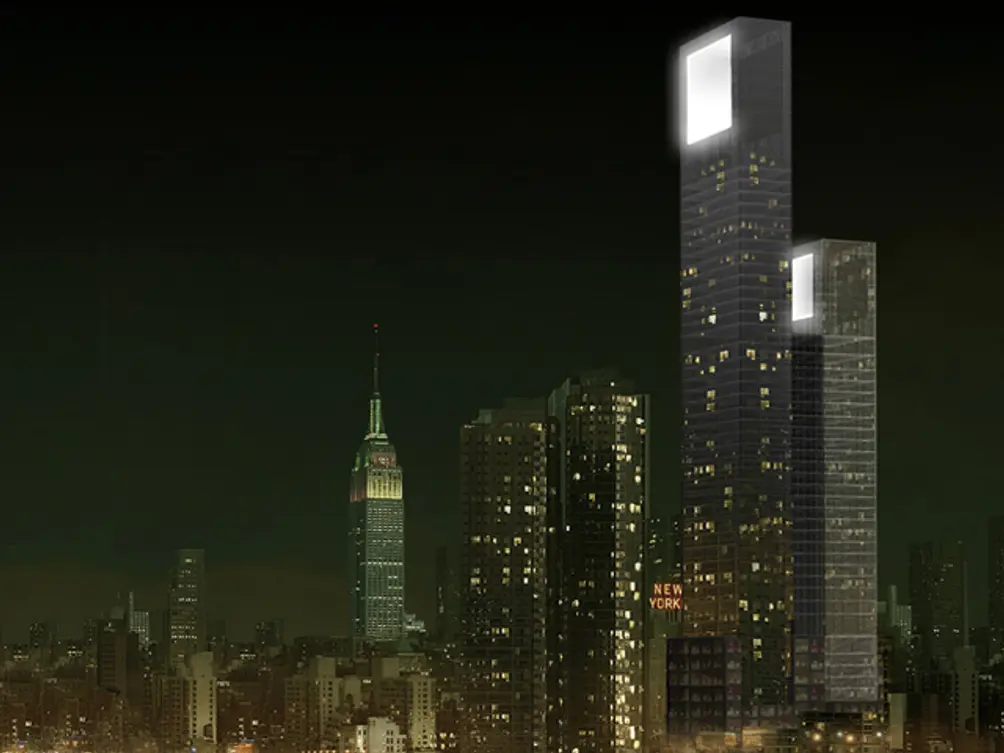 Renderings of 545 West 37th Street (C3D Architecture)
Renderings of 545 West 37th Street (C3D Architecture)
In the wake of the pandemic-induced plummet in tourism, some wondered about the future of New York hospitality. The Chetrit Group has stayed optimistic, though—their plans for a hotel/condo up the street from Hudson Yards have been in the works since the mega-development was still under construction, and recently approved zoning plans show that they will proceed with a two-towered scheme designed by C3D Architecture, which has replaced CetraRuddy as the project architects. At 46 stories and 622 feet high, it is poised to make a definitive statement in the Midtown West skyline.
Upon completion, the tower will feature 421 hotel rooms and 135 condos on top. Residential amenities are set to include storage, bike room, package/mail room, fitness room with spin/yoga/Pilates studio, and lounge. They will presumably have access to the hotel’s amenities as well, which are expected to include restaurants, events rooms, lounges, a pool and sauna, and attended parking.
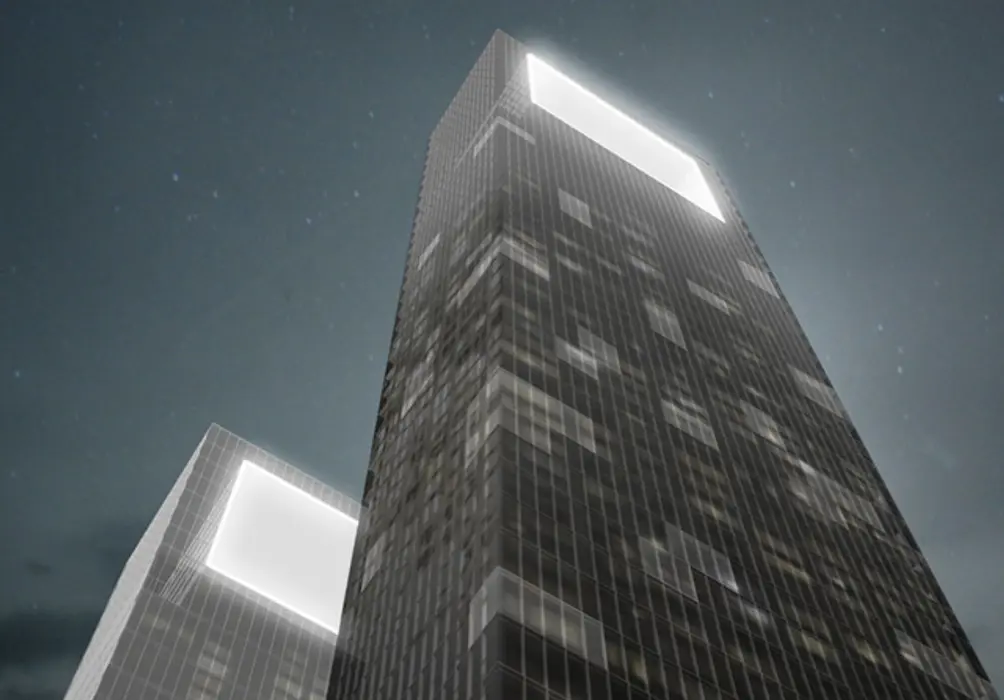

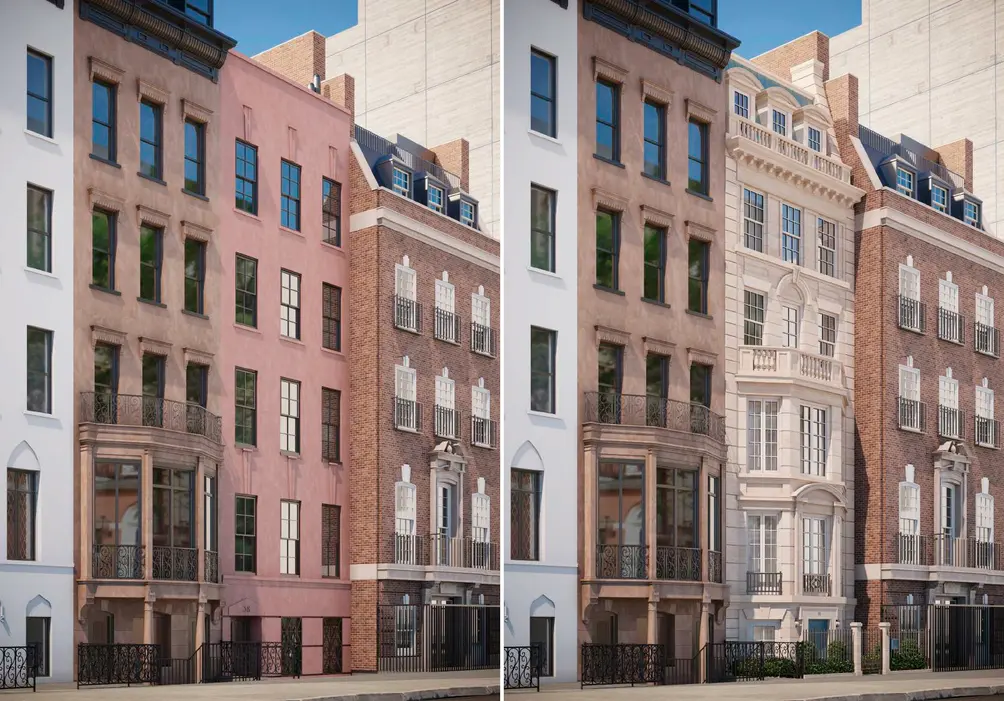 (l-r) Initial Landmarks proposal and revision of 38 East 75th Street (Robert A.M. Stern for Landmarks Preservation Commission)
(l-r) Initial Landmarks proposal and revision of 38 East 75th Street (Robert A.M. Stern for Landmarks Preservation Commission)
It took more than one hearing, but Landmarks ultimately approved a new facade design and the construction of rooftop and rear yard additions for 38 East 75th Street. The rowhouse in the Upper East Side Historic District dates back to the early 1880s, when it was built by Thom & Wilson, and received a new, more modern facade by John Ingle in 1926. Friends of the Upper East Side observes that this building and its neighbors were originally part of an identical row of four, but have experienced unique design evolutions and clear delineations over the years.
Previous comments about perceived heaviness and lack of delicateness were incorporated into the new design. A presentation by Robert A.M. Stern Architects, which Chair Sarah Carroll described as “a master of interpreting appropriate styles in a particular context,” shows a new limestone facade, restrained architectural details, and the elimination of heavier surrounds and jutting upper floors. The facade, cornice detail, balustrade, and dormers are all consistent with Upper East Side design and materiality.
The presentation also shows numerous examples of how other rowhouses in the Upper East Side Historic District have incorporated this to Landmarks’ approval. This particular building was described as a “no-style building” when the Upper East Side Historic District was designated in 1981, which has consistently meant that demolitions and alterations have been consistently approved for this designation. Many commissioners went with this precedent and appreciated the changes from the previous hearing, and the project was approved 8-2.
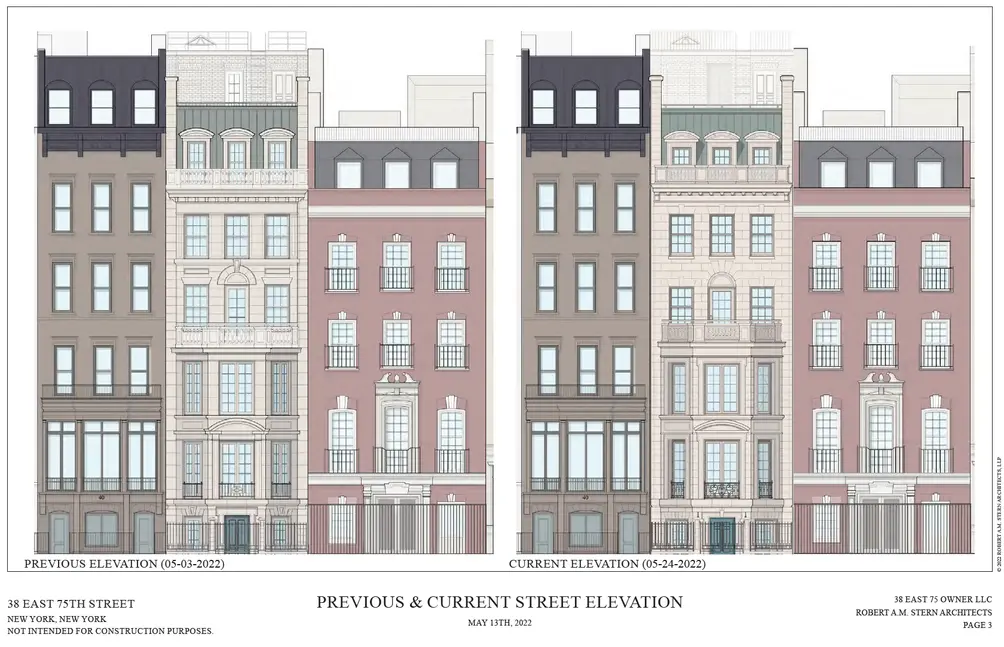

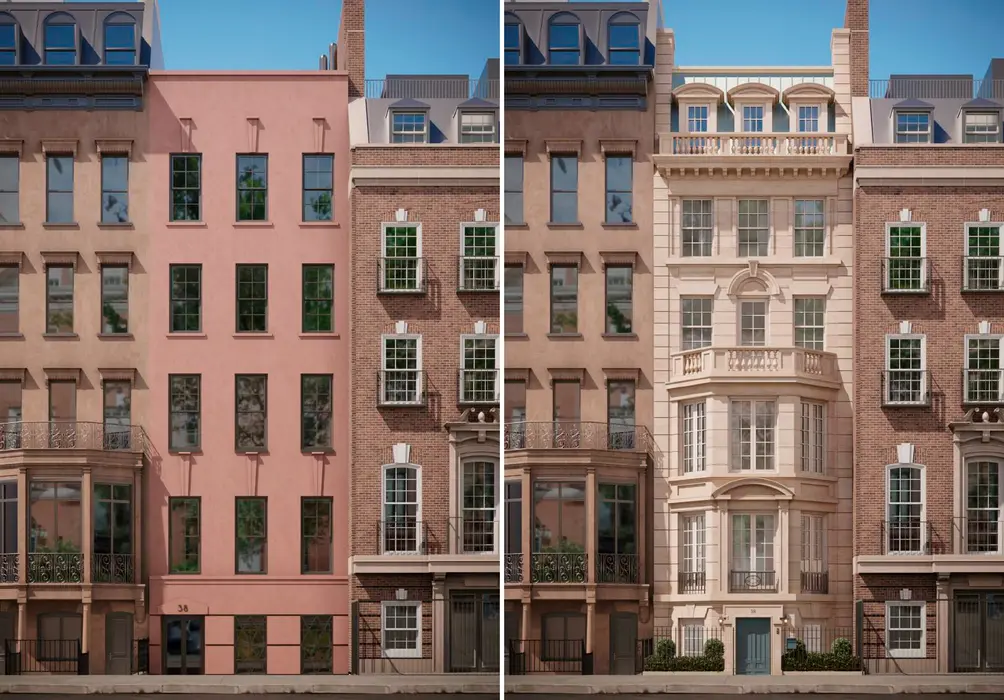
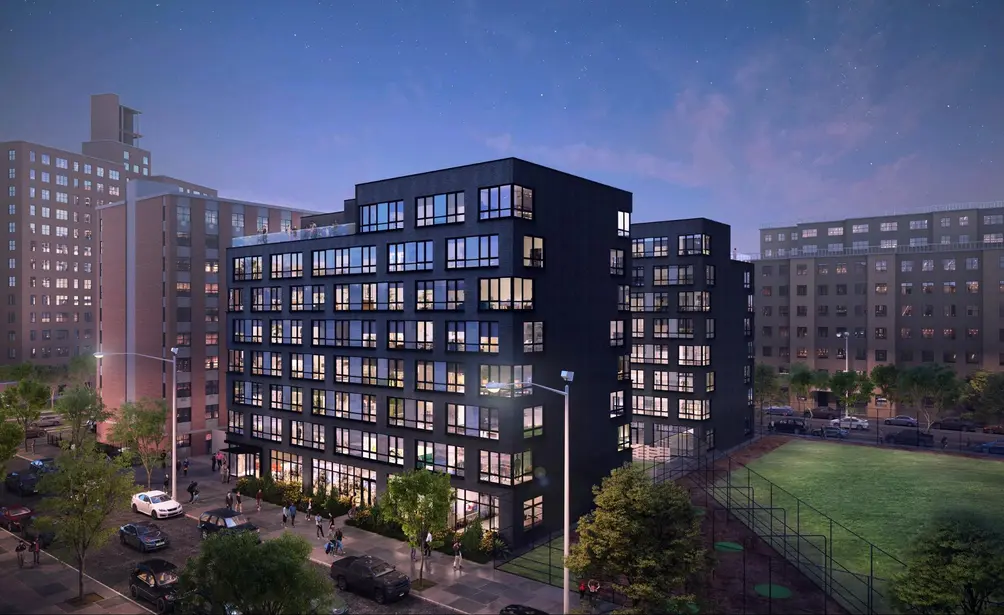 Common Roosevelt (Common)
Common Roosevelt (Common)
Statistics show that the majority of New York City apartments are occupied by single people or single adults living together, and yet there is a shortage of housing for single people in the city. Common and L+M Development Partners seek to change that with Common Roosevelt, their East Harlem proposal.
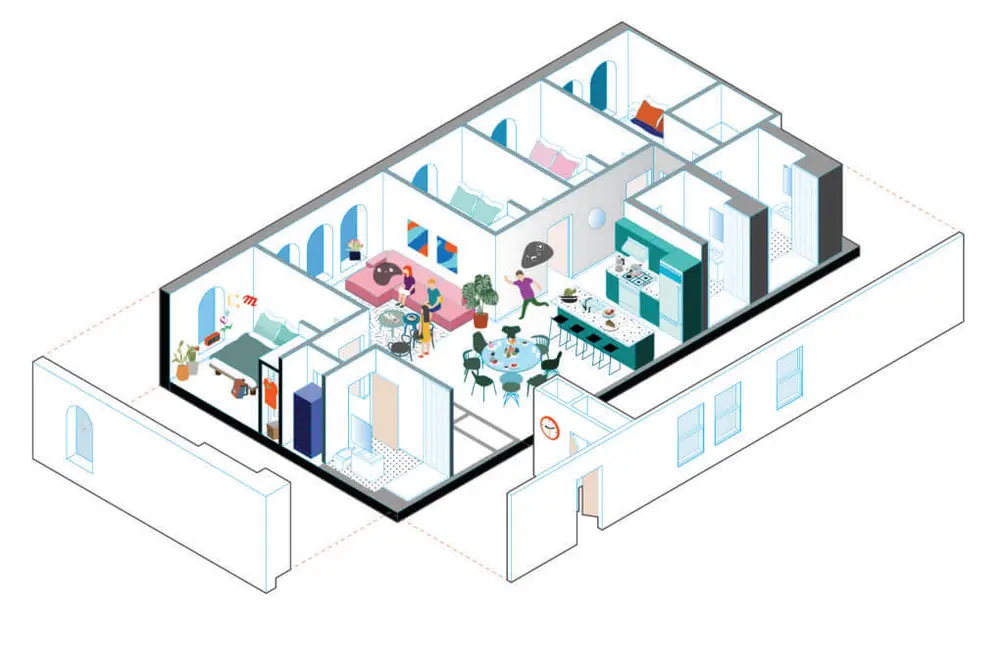 Floor layout (Common)
Floor layout (Common)
Common Roosevelt will offer 253 bedrooms that are designed to share common areas and kitchens (but not shared bathrooms) — for example, one layout shows 19 bedrooms and one large living area with a kitchen and recreation room on one floor. The apartments will be offered to residents at a wide range of incomes, and residents will enjoy such perks as on-site laundry, free weekly cleanings, common outdoor space, a fitness center, and a library.
The project was a winner of Fast Company’s 2020 World Changing Ideas Awards, and also won ShareNYC, the NYC Department of Housing and Preservation’s competition to bring more affordable housing to the city through co-living. However, we should note that the competitions took place pre-pandemic, and the next steps have not yet been spelled out.
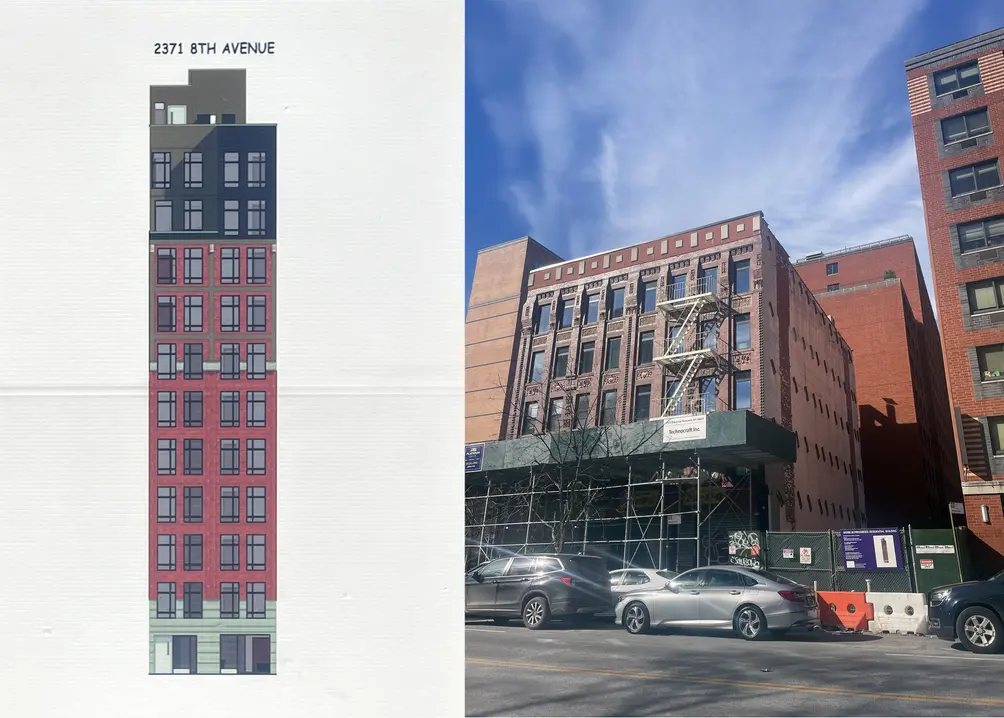 2371 Frederick Douglass Boulevard (CityRealty)
2371 Frederick Douglass Boulevard (CityRealty)
In 2017, permits were filed for an 11-story building to rise on a vacant lot at 2371 Frederick Douglass Boulevard in Harlem. They listed ARC Architecture and Design Studio as the architect of record, and a more recent site visit showed a rendering of a narrow building with a red brick facade and two setback upper levels.
Upon completion, the new building will feature 30 apartments—three on each floor starting on the second story. Amenities will include a basement-level bike room, a fitness room, a lounge, and a central laundry room. The permits emphasize that the roof level is not accessible for recreation, but the site is down the block from St. Nicholas Park. It is also close to the Apollo Theater, popular Harlem restaurants, and the local and express trains at 125th Street.
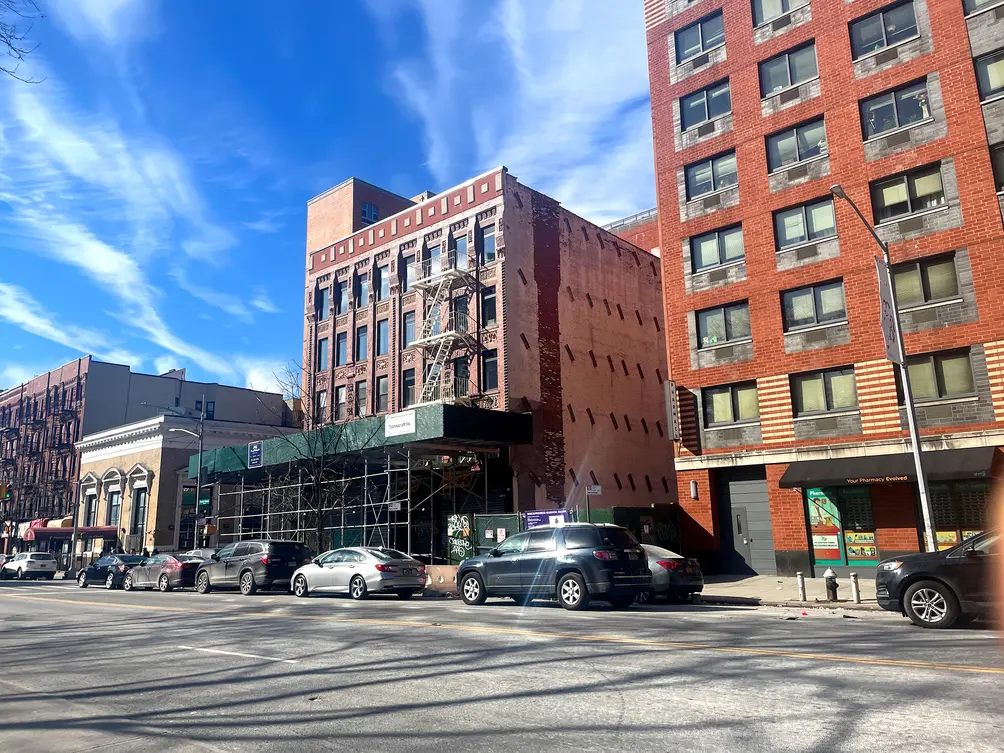
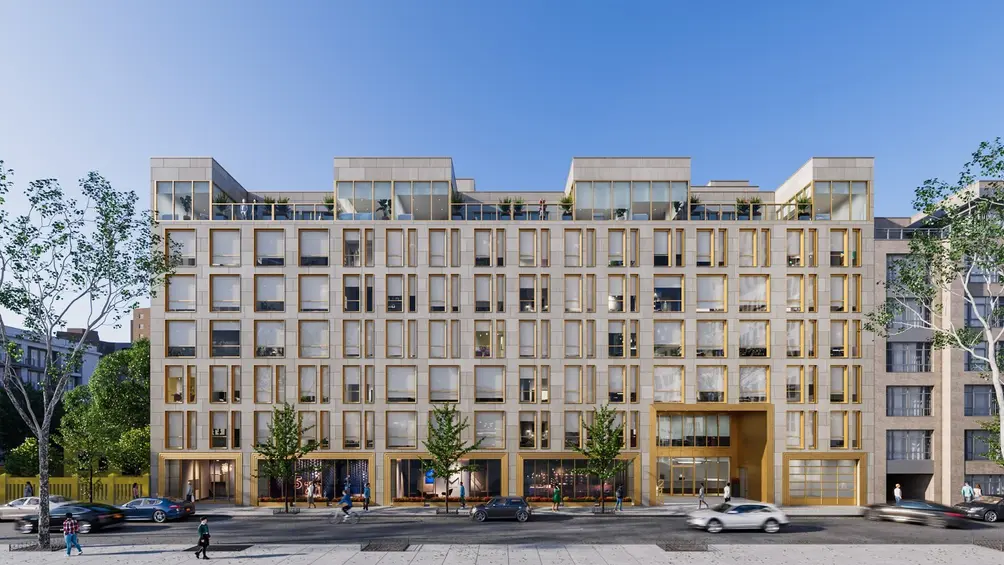 Rendering of 218 Front Street (S. Wieder Architects)
Rendering of 218 Front Street (S. Wieder Architects)
DUMBO has taken its place as one of Brooklyn’s most in-demand neighborhoods, and the nearby Vinegar Hill is on the rise as well. In its latest entrant, Urban Realty Partners is developing a new seven-story building at 218 Front Street. Designer S. Wieder Architects recently revealed a new facade design for it on their Instagram page. The rendering depicts a rooftop deck, and there will also be on-site parking spaces.
Upon completion, the new building will have retail space and community space on the first floor and 218 residences on top. Demolition permits for the one-story warehouse on-site were filed in November 2021, and a completion date has not yet been provided.
Upon completion, the new building will have retail space and community space on the first floor and 218 residences on top. Demolition permits for the one-story warehouse on-site were filed in November 2021, and a completion date has not yet been provided.
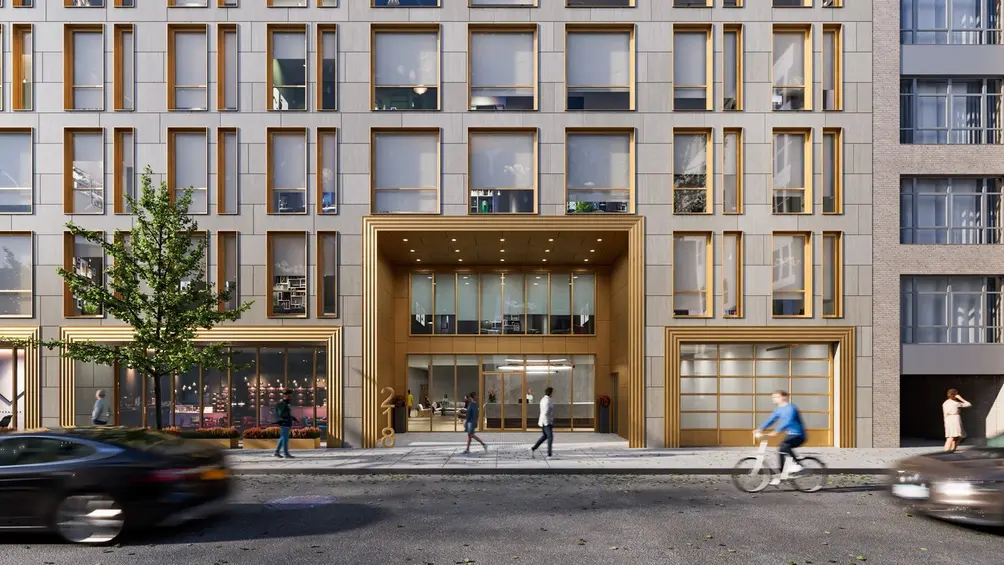 218 Front Street entrance
218 Front Street entrance
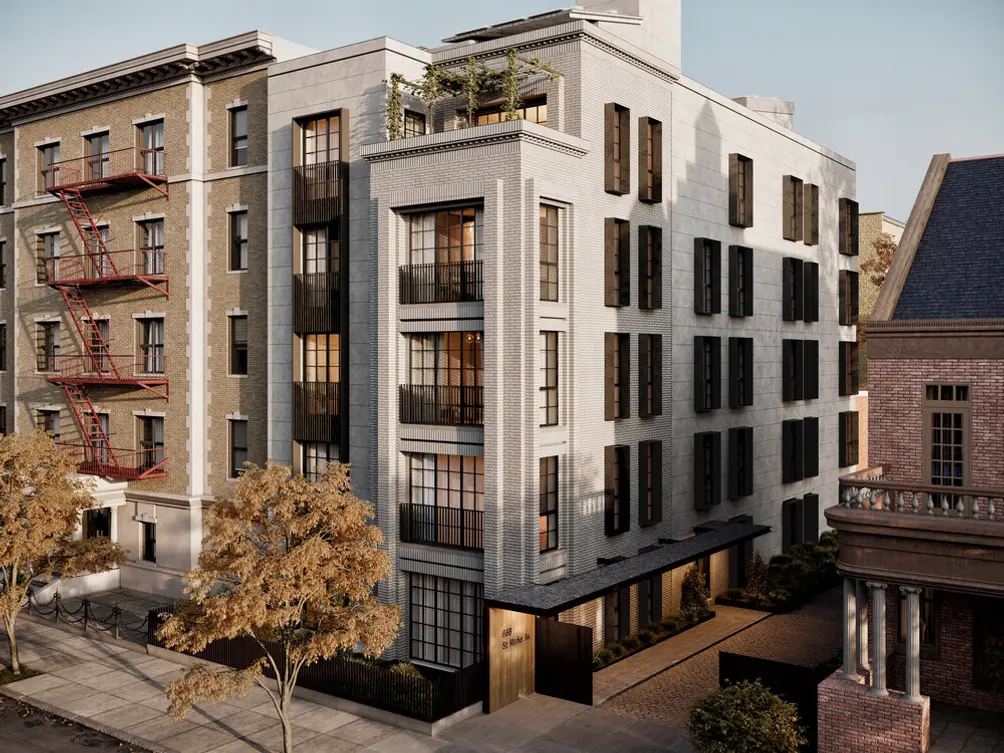 Renderings of 669 Saint Marks Avenue (Cycle Architecture + Planning)
Renderings of 669 Saint Marks Avenue (Cycle Architecture + Planning)
When demolition permits were filed for the two-story townhouse at 669 Saint Mark’s Avenue, plans quickly emerged for its condo replacement. An earlier design showed a red brick facade and arch-topped bay, but the latest rendering by OMA Architects shows a white brick facade with massive windows in front, dark-framed windows on the side, and private outdoor space for each of the 10 units. While located just outside the Crown Heights Historic District, and thus exempt from the limitations imposed by that, the new building pictured is nevertheless sensitive to its surroundings in terms of height and materiality.
Would you like to tour any of these properties?
Just complete the info below.
Or call us at (212) 755-5544
In any event, the facade will go on top of a high-efficiency building envelope for a building designed to Passive House standards. Reuse of building materials diverts demolition waste from landfills, and the finished product will feature on-site stormwater management and on-site compost and recycling bins that make it easier for residents to do their part. The commitment to environmental friendliness also comes through in the building’s amenities, which include a bike room (no on-site parking here!), a garden, and a roof deck.
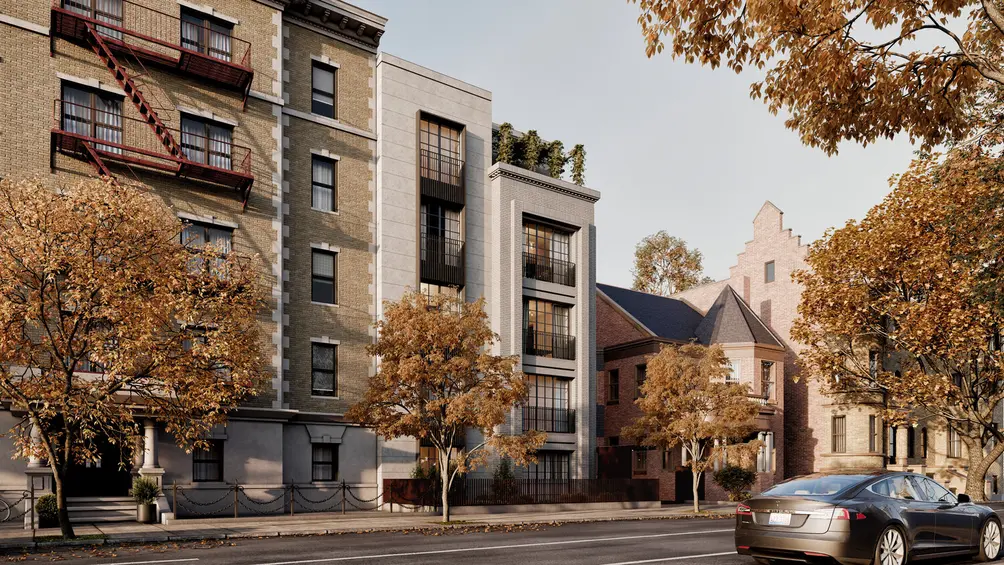

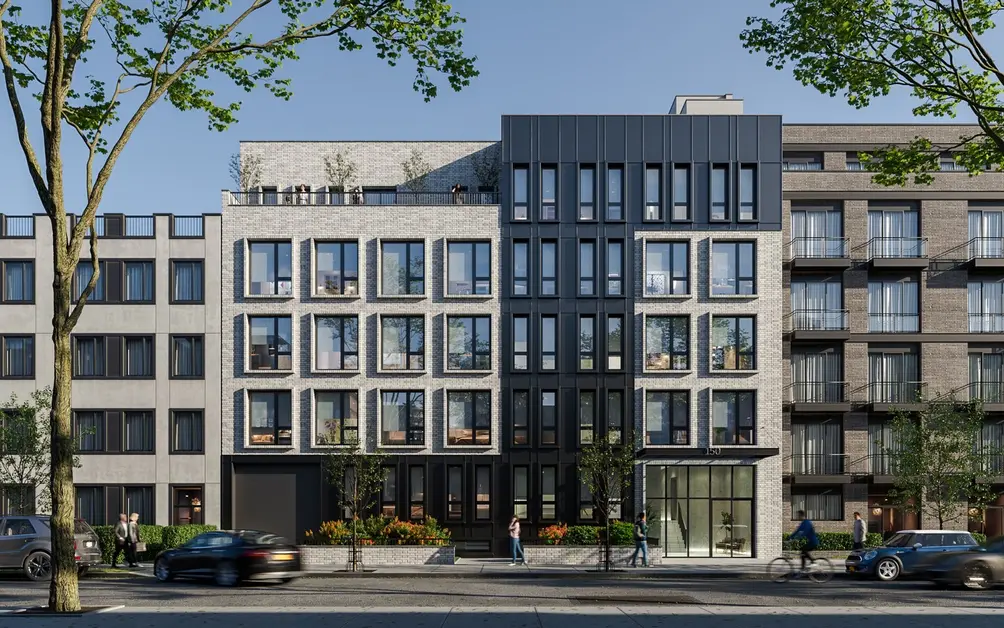 Rendering of 150 Erasmus Street (S. Wieder Architects)
Rendering of 150 Erasmus Street (S. Wieder Architects)
In December 2017, permits were filed for a 10-unit residential building on the former site of a two-story house at 150 Erasmus Street. More recently, designer S. Wieder Architects revealed their facade design for the building on Instagram. It depicts a four-story building with a two-toned brick and stone facade, oversized windows, and a setback that allows for a large outdoor terrace. There will be no more than three units per floor, and two duplex units on the penthouse level.
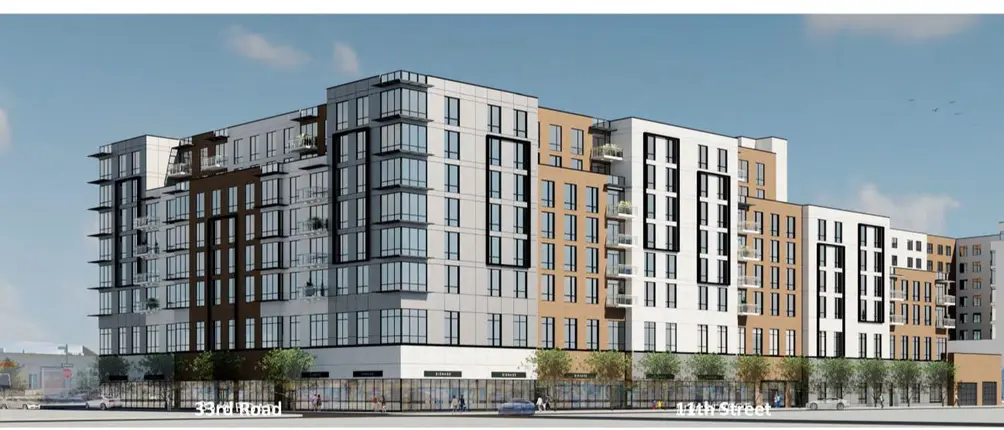 Renderings of 33-33 11th Street
Renderings of 33-33 11th Street
It didn’t take long for “the cool factor” to come to Astoria, but new housing is moving a little more slowly: A rezoning application for a new development comprising two eight-story buildings at 33-33 11th Street started at the end of 2020 and is still in progress. The area is highly industrial, and developers JPP 33rd Street LLC and Lily & John Realty Inc. required the upzone to increase the density required for the project.
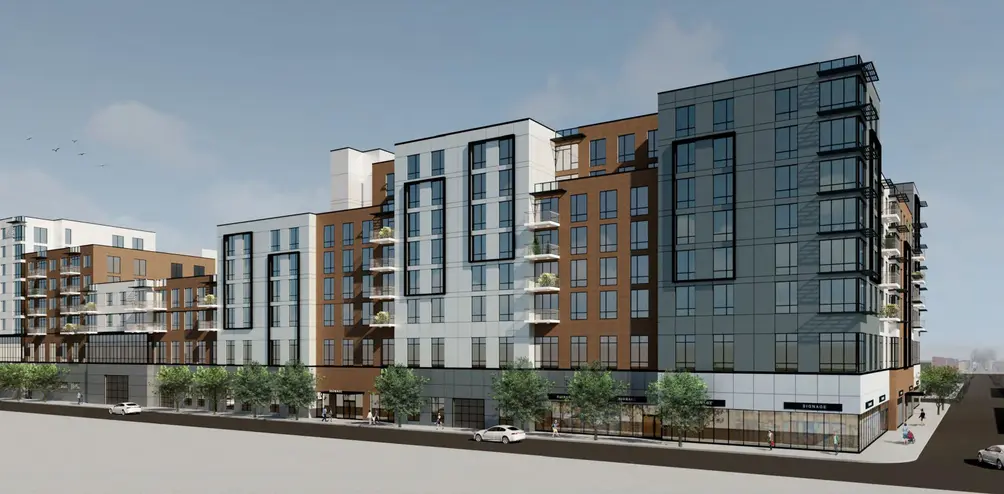
The first building will contain 194 housing units and nearly 90,000 square feet of space that would be used for local retail, artists’ studios, and two trade schools: the Andromeda Community Initiative, which provides free educational programs to help people gain employment in the construction industry, and York Studios, which offers programs in film and television production (highly useful with Silvercup Studios just over a mile away).
The second building is set to feature 138 housing units, ground-floor retail, tech office space, and 24,000 square feet of space to be leased to a food distribution company. It will also contain 10,000 square feet of space for a local non-profit.
The second building is set to feature 138 housing units, ground-floor retail, tech office space, and 24,000 square feet of space to be leased to a food distribution company. It will also contain 10,000 square feet of space for a local non-profit.
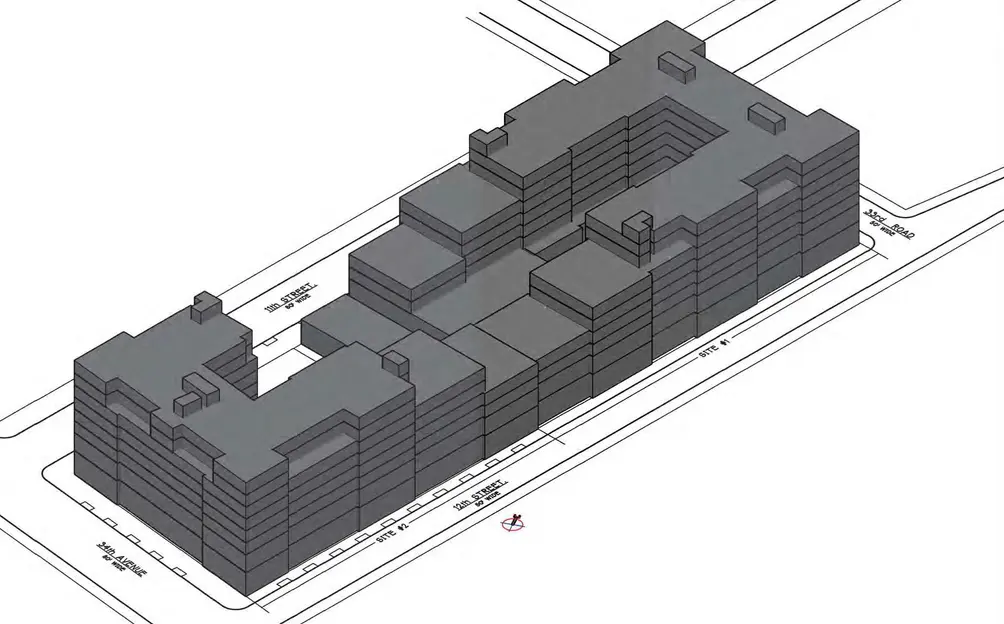
The 352 apartments between the two buildings are set to comprise 24 studios, 148 one-bedrooms, 114 two-bedrooms, and 46 three-bedrooms. A total of 82 units (or 25 percent) has been designated as affordable, but Queens Community Board 1 rejected the project in March 2022 on grounds that it wouldn’t provide affordable housing at income levels appropriate for Astoria residents. However, the Queens Borough President found it favorable, and the City Planning Commission’s review began earlier this month.
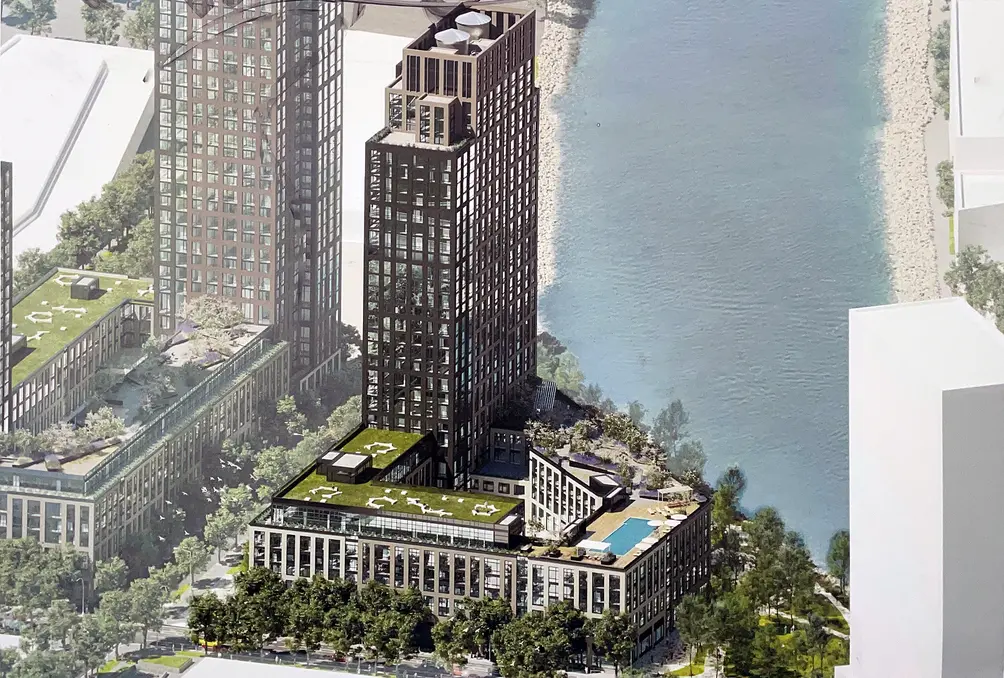 2-20 Malt Drive rendering (TF Cornerstone)
2-20 Malt Drive rendering (TF Cornerstone)
A few short weeks after Gotham Point welcomed its first residents, construction of the Hunters Point South master plan is still going strong: A recent site visit showed work well underway on 2-20 Malt Drive, also known as Hunters Point South B-S. The building will ultimately measure 34 stories and 390 feet high and feature a design by SLCE Architects. TF Cornerstone is at the helm of the project.
Permits list on-site parking, a mailroom, a package room, bike storage, resident storage, a central laundry room with adjacent terrace, a children’s playroom with outdoor terrace, a fitness center, and an outdoor pool among amenities. They also indicate that a portion of the 575 units will have private outdoor space, and that the building will have a cogeneration plant on-site.
Permits list on-site parking, a mailroom, a package room, bike storage, resident storage, a central laundry room with adjacent terrace, a children’s playroom with outdoor terrace, a fitness center, and an outdoor pool among amenities. They also indicate that a portion of the 575 units will have private outdoor space, and that the building will have a cogeneration plant on-site.
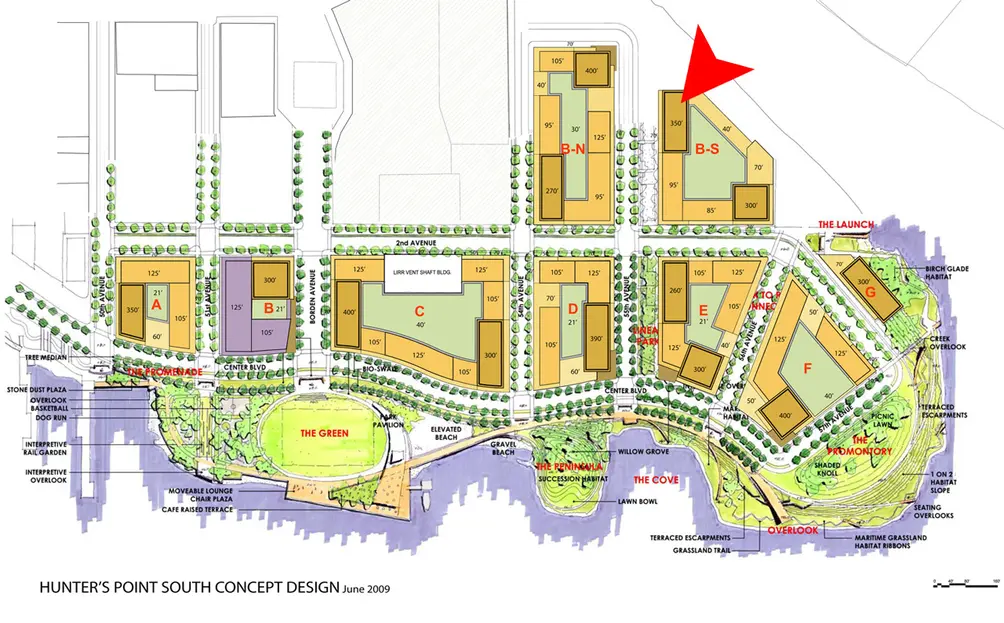
 Construction progress, May 2022 (CityRealty)
Construction progress, May 2022 (CityRealty)
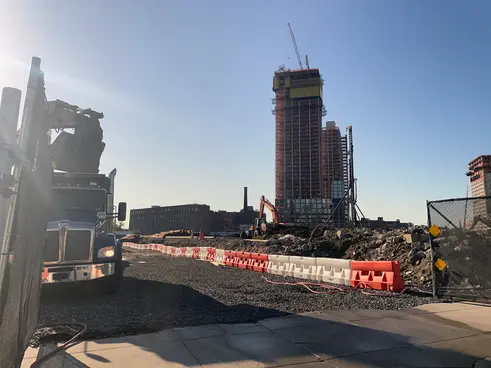
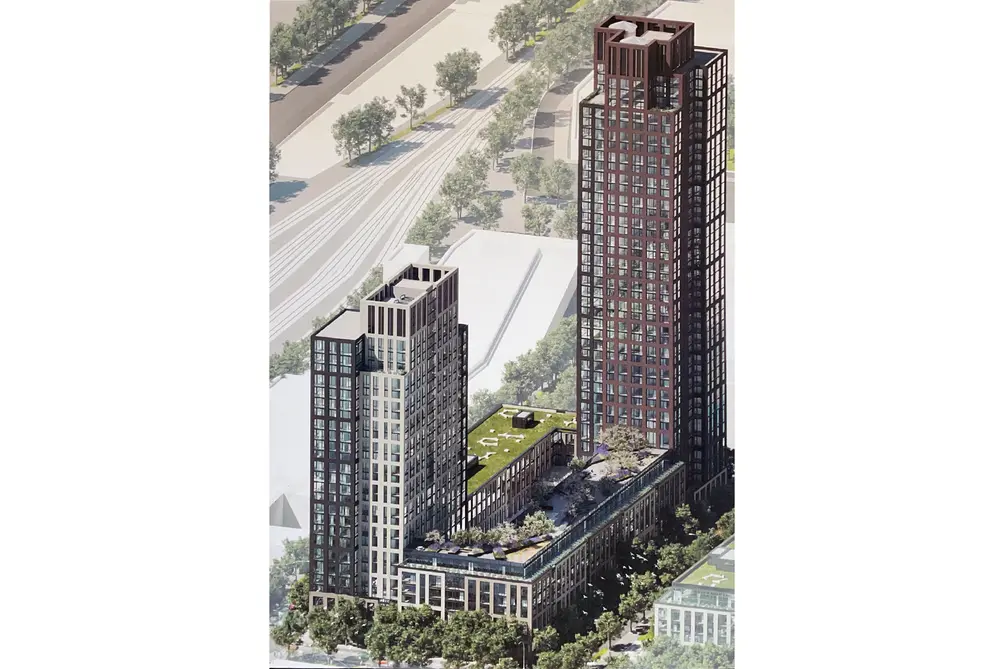
Across the way from Hunters Point South B-S (see above), a two-towered development is taking shape at 2-21 Malt Drive, also known as Hunters Point South B-N. The east tower will rise 440 feet to the bulkhead top, and the west tower will measure 310 feet high. Like their counterpart across the street, the buildings will be developed by TF Cornerstone and designed by SLCE Architects.
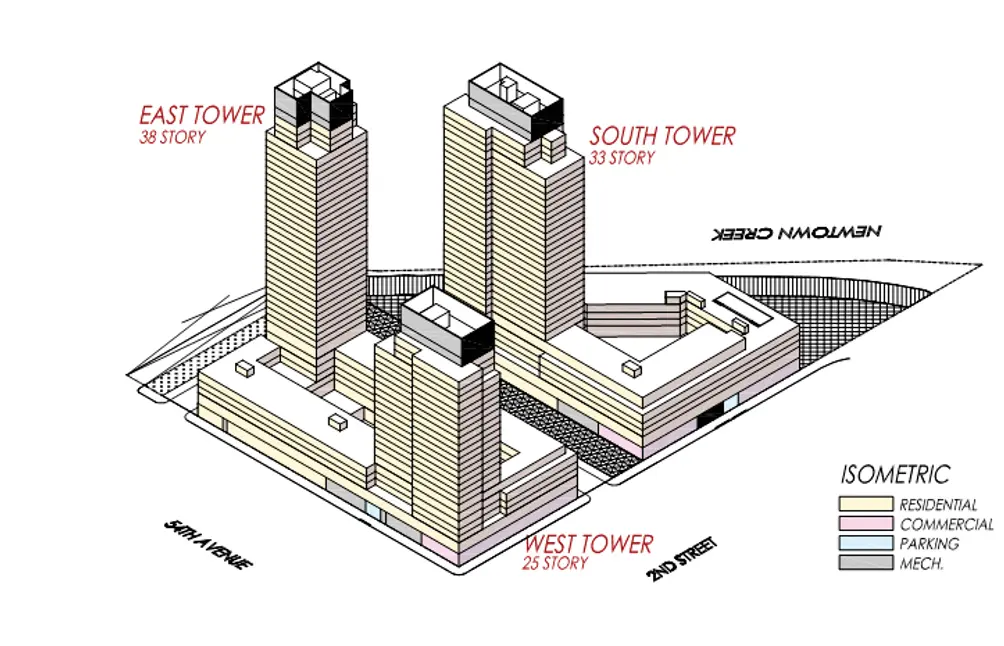 Hunters Point South B-N map
Hunters Point South B-N map
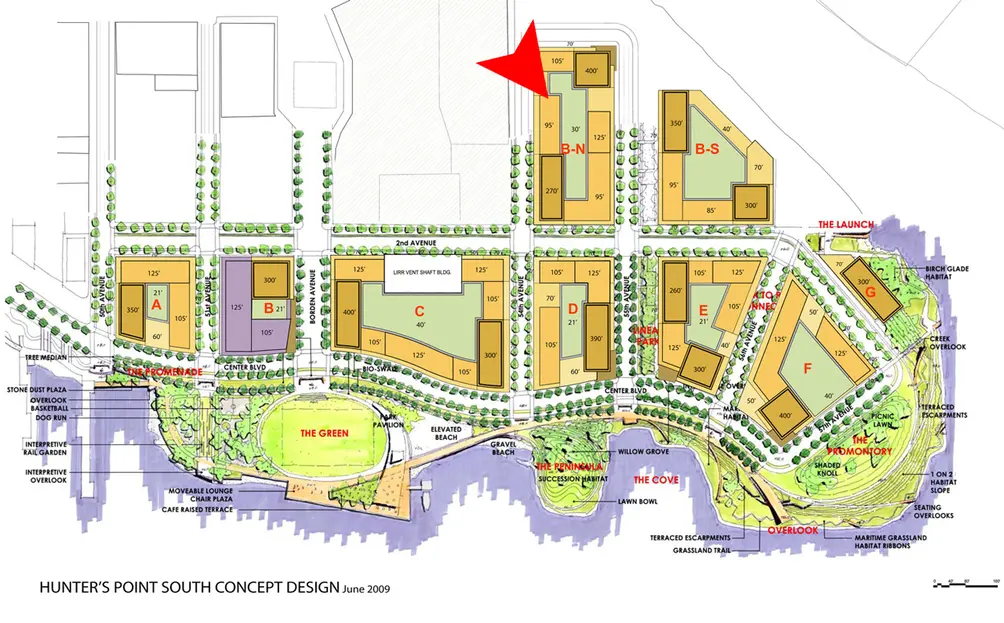 Hunters Point South site map
Hunters Point South site map
Permits state that apartments will start on the second floor, and select units will feature private terraces. Amenities in the two towers will include storage, mailrooms, package rooms, laundry rooms, a fitness center, recreation rooms with outdoor terraces, and an outdoor children’s playground. It will also feature 40 accessory parking spaces and bike rooms on the first and third floors, but there is no shortage of ways to get around: The site is located a short distance from the Hunters Point South ferry stop and the Long Island City LIRR stop.
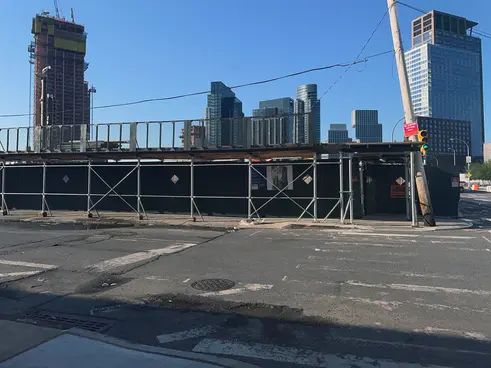 Construction progress (CityRealty)
Construction progress (CityRealty)

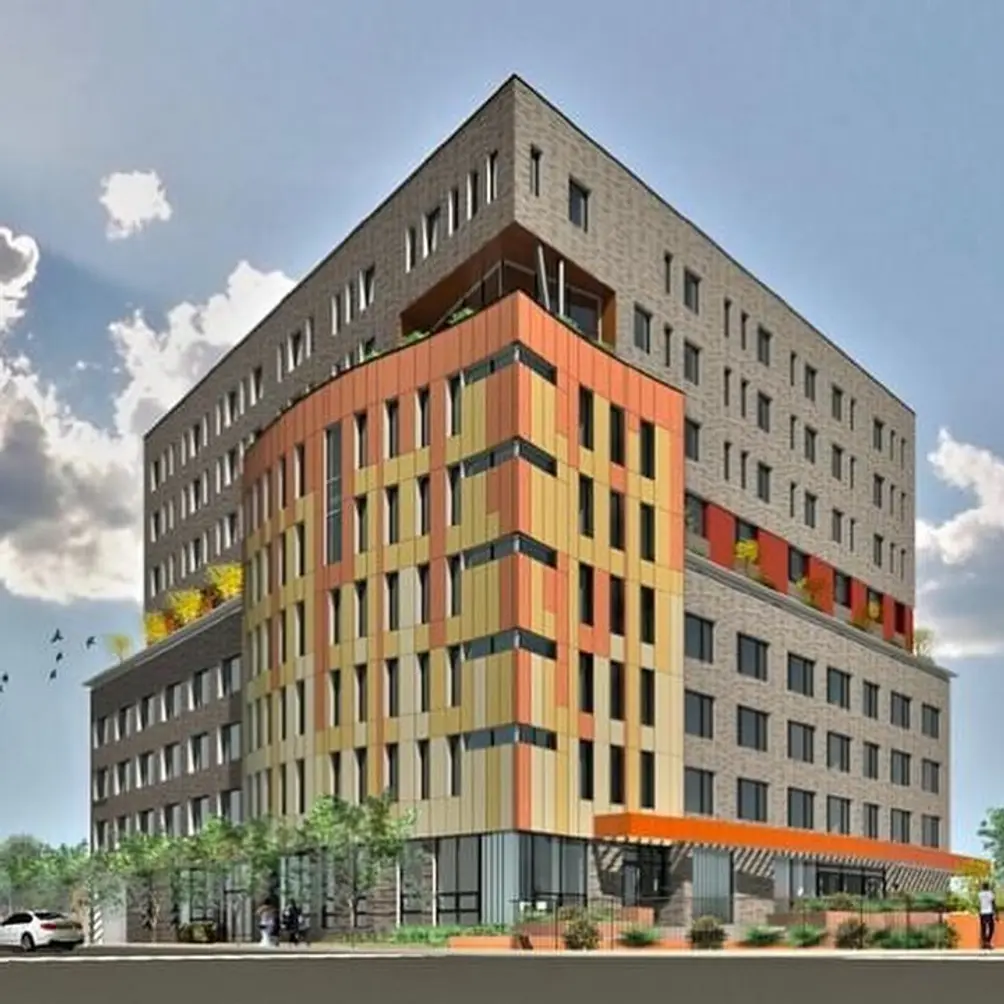 Rendering of 20-50- Nameoke Avenue (Urban Architectural Initiatives)
Rendering of 20-50- Nameoke Avenue (Urban Architectural Initiatives)
Construction is underway on 20-50 Nameoke Avenue, a nine-story apartment building in Far Rockaway. Permits list Urban Architectural Initiatives as the designer of record and indicate that amenities will include an exercise room, a rooftop terrace, a library, a central laundry room, a bike room, and 13 parking spaces.
Of the 117 units, 46 will be designated affordable housing and 71 will be set aside for the formerly homeless and people recovering from mental illness. Social services company Federation of Organizations (FOO) will provide services that include life skills training, crisis intervention, and community integration. Members of Queens Community Board 14 expressed concern about the population of the 71 units in an April 2021 meeting about the project, but FOO emphasized that there would be a thorough screening process for potential residents.
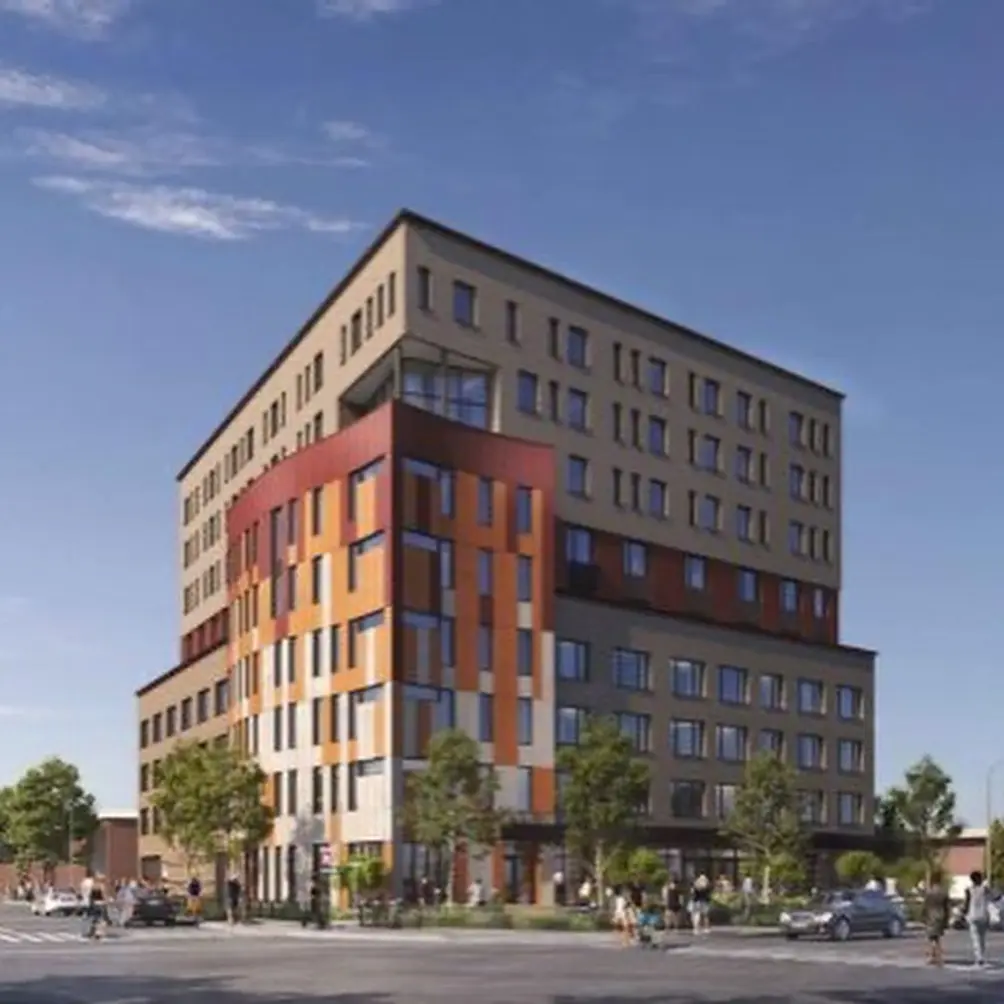
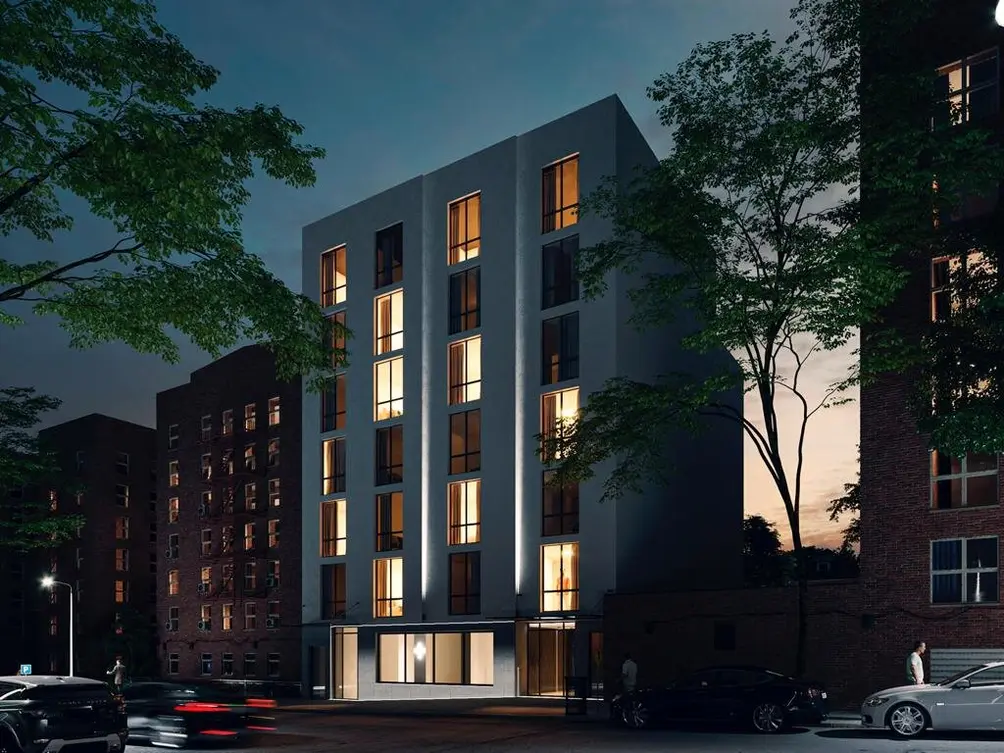 2279 Barker Avenue (Affordable Living NY)
2279 Barker Avenue (Affordable Living NY)
Construction is underway on 2279 Barker Avenue, a seven-story building in the Allerton section of the Bronx. Permits list Dome Architecture as the designer of record and indicate that the building will feature a first-floor community facility and 23 apartments from the second story up. Elena Borokhovich of Affordable Living NY is listed as the owner.
Residential amenities are set to include a second-floor lounge, a basement-level laundry room, a bike room, and an elevator. While the building does not offer any outdoor space, it is located near Bronx Park, New York Botanical Garden, and the Bronx Zoo. The Pelham Parkway 2 and 5 subway stop is a few blocks away.
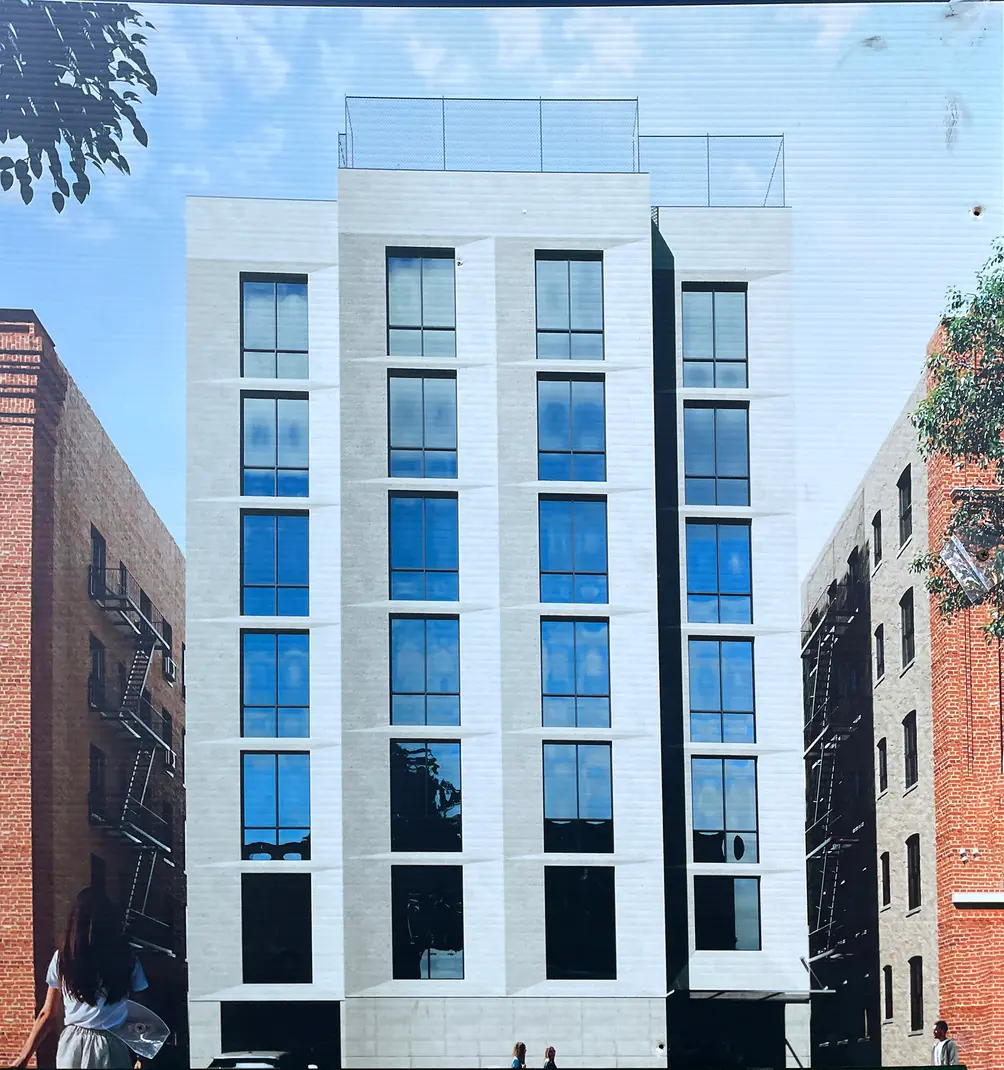 Rendering of 1791 Marmion Avenue (Dome Architecture)
Rendering of 1791 Marmion Avenue (Dome Architecture)
A recent visit to the site of 1791 Marmion Avenue shows that the seven-story building is out of the ground and on the way up. Upon completion, it will feature a design by Dome Architecture and 27 residential units (most likely rentals).
As per building permits, amenities will include a bike room, elevator, and roof terrace. The building will also offer eight on-site parking spaces, but it is a short distance from the 175th Street 2 and 5 trains. It is also down the street from Crotona Park and its sports courts, amphitheater, playgrounds, and walking paths.
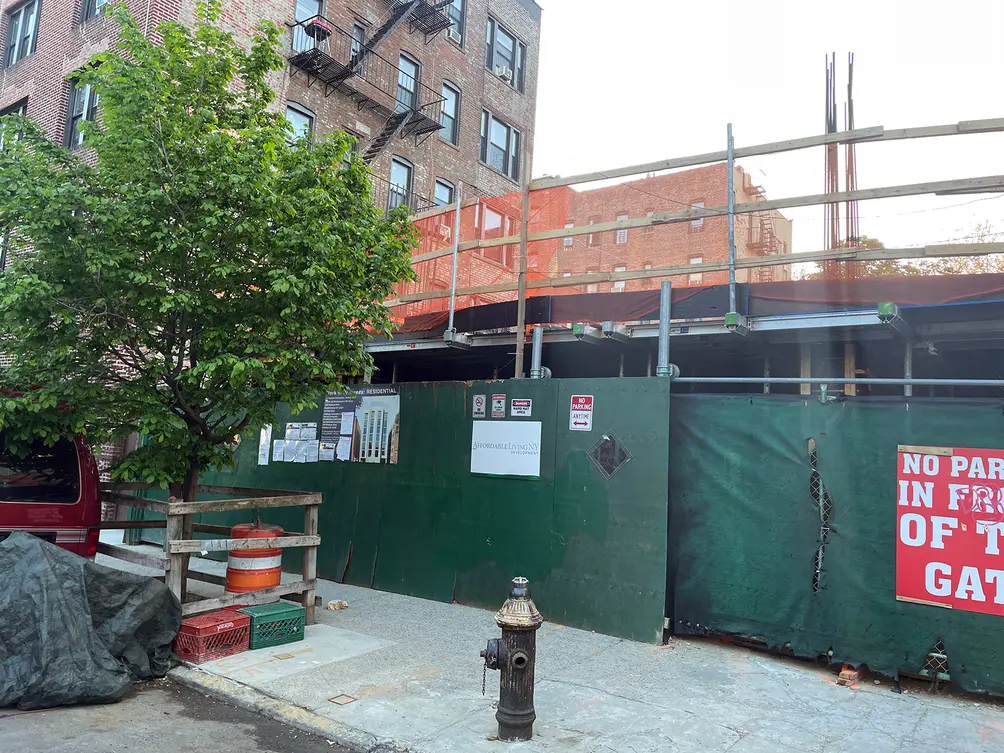 Construction progress, May 2022 (CityRealty)
Construction progress, May 2022 (CityRealty)
Hudson Exchange Phase 2, Jersey City
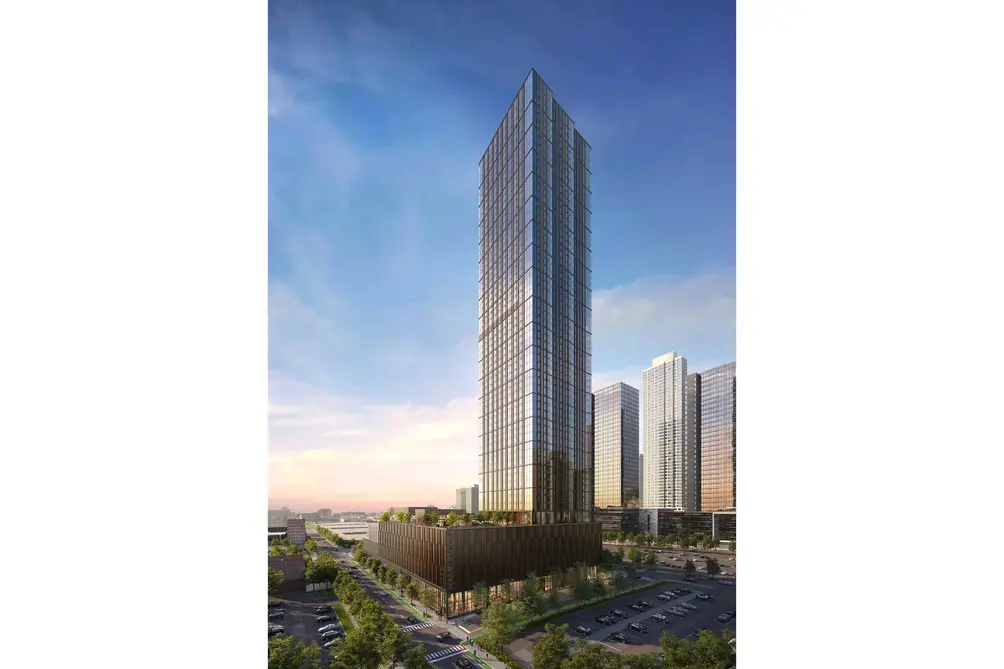 Hudson Exchange Phase 2 renderings (G&S Investors)
Hudson Exchange Phase 2 renderings (G&S Investors)
Fresh off the completion of VYV, the two-towered first phase of their Hudson Exchange project, developer G&S Investors has submitted an application for one of Jersey City’s tallest buildings as part of the next phase. 400-420 Marin Boulevard is currently home to a shuttered Bed Bath & Beyond, but plans call for a 60-story, 634-foot high building to be designed by Beyer Blinder Belle. Renderings depict a soaring tower rising from a podium, the roof of which allows for outdoor recreation space.
The 802 residential units are set to comprise 80 studios, 399 one-bedrooms, 295 two-bedrooms, and 38 three-bedrooms. Jersey Digs notes that despite Jersey City’s recently enacted affordable housing ordinance, no mention has been made of any affordable units in the project. No mention has been made of residential amenities either, but the project will feature a parking garage with room for 538 cars and 422 bicycles.
In addition to the housing units, the new tower will feature 118,401 square feet of retail space that will include a new, 85,000-square-foot Shop-Rite supermarket. It is located south of Newport City Mall, north of the Grove Street PATH, and across from Sixth Street Embankment, a long-stalled greenery project that fancies itself Jersey City’s answer to the High Line. G&S Investors went in front of the city planning board in April (h/t NJ.com), and site plan approval is required before it can proceed. When it ultimately does, construction is expected to take three years.
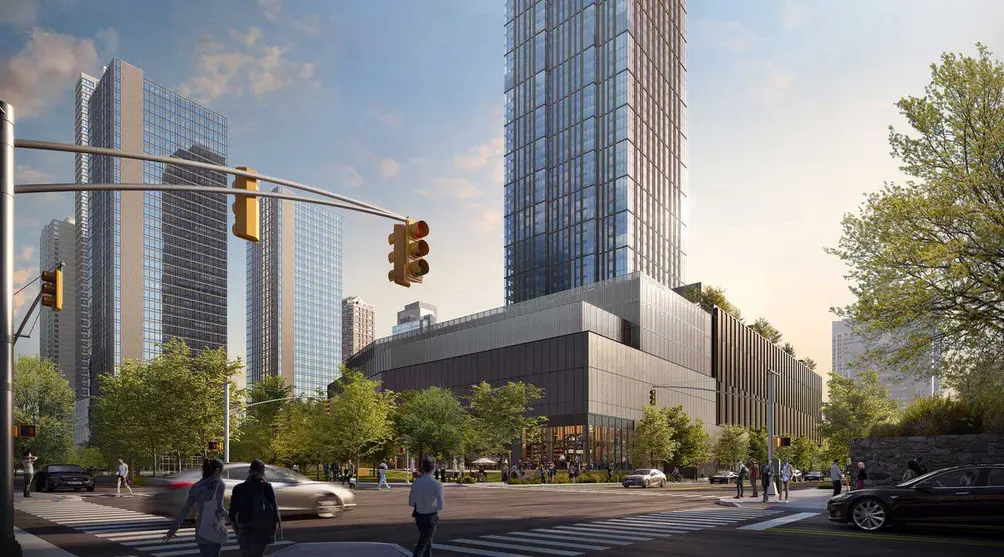
140 Front Street, Financial District
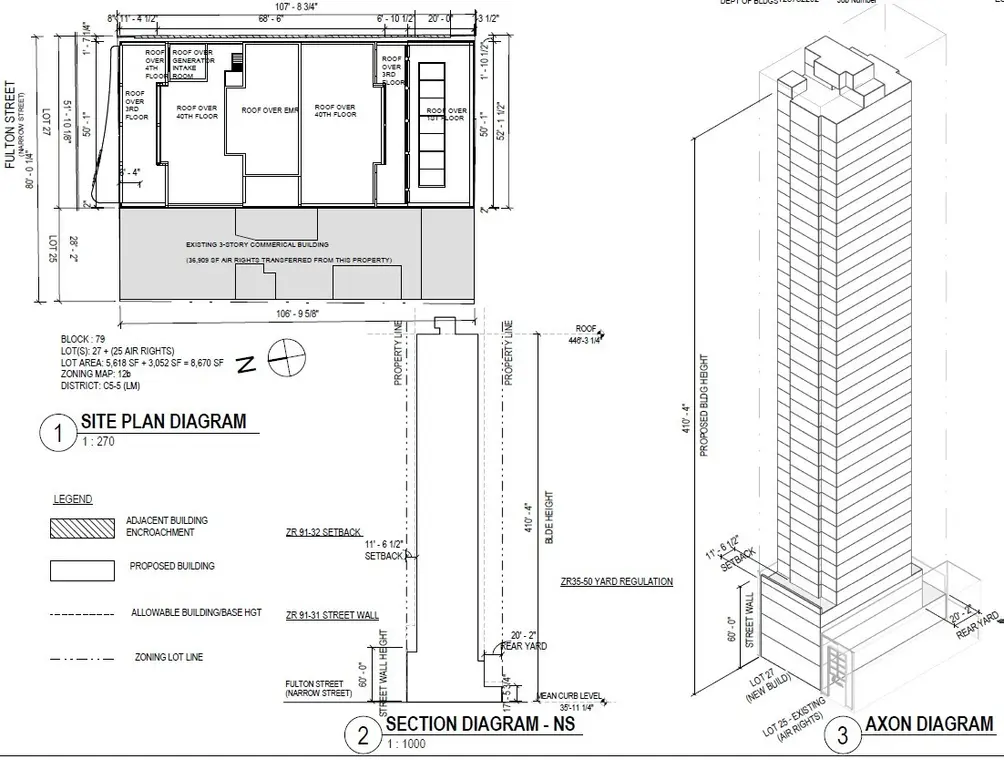 Site plan diagram (NYC Department of Buildings)
Site plan diagram (NYC Department of Buildings)
Between the resurgent South Street Seaport, a luxury shopping and dining scene, and the convenience of the Fulton Street transportation hub, Lower Manhattan is emerging as a high-end hospitality hub. The latest entrant is a 40-story hotel at 140 Fulton Street, to be developed by Hidrock (and listed as 140 Fulton LLC on permits).
Permits indicate that there will be no more than eight rooms per floor, and that the new building will feature a ground-floor restaurant and second-floor lobby, luggage room, and fitness center. Architect of record Stonehill Taylor’s extensive hospitality portfolio includes the nearby Millennium Hilton and Moxy Downtown. The tenant has not yet been announced, nor has the estimated completion date.
Would you like to tour any of these properties?
Just complete the info below.
Or call us at (212) 755-5544
Would you like to tour any of these properties?




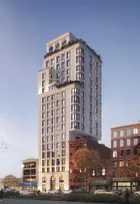


 6sqft delivers the latest on real estate, architecture, and design, straight from New York City.
6sqft delivers the latest on real estate, architecture, and design, straight from New York City.
